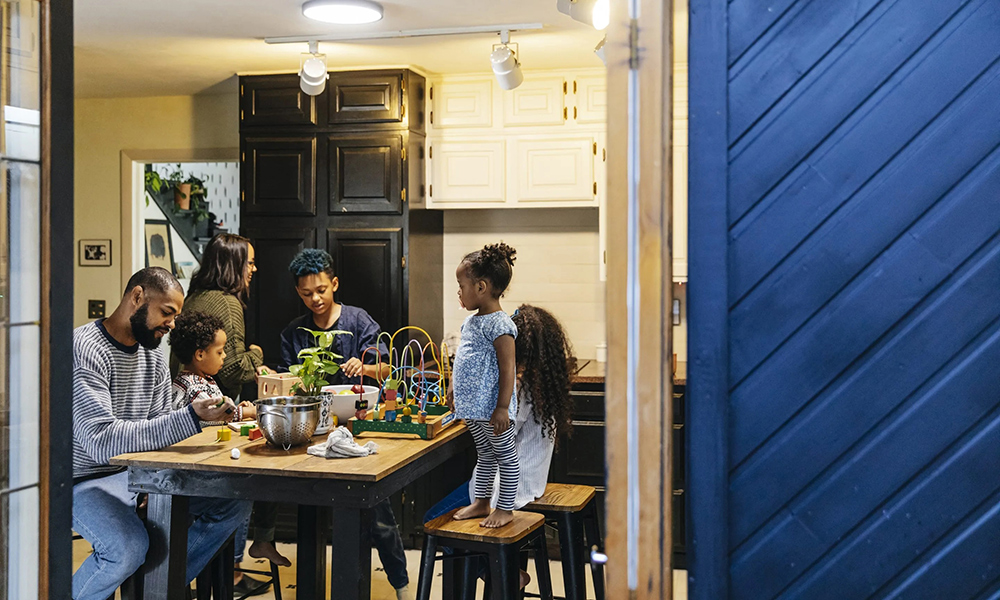美国中产阶级的黄金时代已接近尾声

辛普森一家和50%左右的美国家庭有什么共同点?除了喜欢甜甜圈和有喜欢说“闭嘴”(eat my shorts)的孩子,他们还都属于中产阶级。
疫情期间,由于政府发放了各种补贴,加上开支有所减少,美国中产阶级的储蓄达到了前所未有水平。从2020年3月到2022年1月,美国家庭的储蓄额外增加了约2.5万亿美元。
由加州大学伯克利分校经济学家提供、彭博社发布的最新数据显示,2022年3月,美国中产阶级家庭的财富达到了创纪录的39.33万美元。彭博社指出,相较于2017年1月特朗普总统上任之时,美国成年中产阶级的人均储蓄增加了12万美元。
这是属于疫情前已开始收缩的中产阶级的黄金时代。但现在,这种财富热潮已经开始消退:伯克利分校经济学家表示,今年3月至10月中旬,占美国人口40%的中产阶级的平均财富已经下降了7%,相当于减少约27000美元。自2008年全球金融危机以来,还是第一次出现这种程度的跌幅,不可谓不巨大。
而这又是经济不确定性酿成的完美风暴的杰作:利率上升,市场低迷,经济衰退的谣言无处不在,通胀水平居于数十年高位、银行里的钱日渐贬值。随着生活成本的增加,越来越多的家庭只得动用疫情期间存下的积蓄贴补家用。
现在,能够做到收支平衡的美国人越来越少。根据《金融健康脉搏2022年美国趋势报告》(Financial Health Pulse 2022 U.S. Trends Report)提供的数据,在开展相关调查的五年以来,符合财务健康条件的美国人数量首次出现下降(2022年,该数字从34%下降到31%)。不过由于疫情前美国人储蓄意愿较低,这一数字仍高于疫情前水平。
在经济衰退之声甚嚣尘上的当下,对于经济安全而言,收入无法覆盖生活成本显然不是个好迹象。
中产阶级常被视为美国梦的象征,而所谓美国梦往往又离不开稳定的收入和拥有房屋产权,而随着通胀加剧导致生活成本日益高企,想要维系这种生活也变得越来越难。在那些有关“自力更生”的故事中,中产阶级家庭的成功常被视为国家成功的风向标(或者至少在许多美国选举中是如此)。而随着收入减少、收入差距扩大,这种许多人耳熟能详的美国梦也开始破灭。
中产阶级的实际人数也出现萎缩。皮尤研究中心(Pew Research Center)的一项分析显示,1971年,61%的美国成年人被认为属于中产阶级,到2021年,这一数字已下降到区区50%。目前,认为自己属于中产阶级的美国人已少于大衰退之前。
虽然上层阶级的收入增幅能够抵消掉通胀的影响,但中产阶级的收入增幅往往无法跑赢通胀。金融服务公司Primerica的一项调查显示,大多数中产阶级家庭(75%)认为通膨增速大于自己的收入增速。
虽然彭博社的数据显示,中产阶级的财富仍然相当可观,但受低迷经济影响,其新积累的财富正在被不断蚕食,令中产阶级不胜焦虑。(财富中文网)
译者:梁宇
审校:夏林
辛普森一家和50%左右的美国家庭有什么共同点?除了喜欢甜甜圈和有喜欢说“闭嘴”(eat my shorts)的孩子,他们还都属于中产阶级。
疫情期间,由于政府发放了各种补贴,加上开支有所减少,美国中产阶级的储蓄达到了前所未有水平。从2020年3月到2022年1月,美国家庭的储蓄额外增加了约2.5万亿美元。
由加州大学伯克利分校经济学家提供、彭博社发布的最新数据显示,2022年3月,美国中产阶级家庭的财富达到了创纪录的39.33万美元。彭博社指出,相较于2017年1月特朗普总统上任之时,美国成年中产阶级的人均储蓄增加了12万美元。
这是属于疫情前已开始收缩的中产阶级的黄金时代。但现在,这种财富热潮已经开始消退:伯克利分校经济学家表示,今年3月至10月中旬,占美国人口40%的中产阶级的平均财富已经下降了7%,相当于减少约27000美元。自2008年全球金融危机以来,还是第一次出现这种程度的跌幅,不可谓不巨大。
而这又是经济不确定性酿成的完美风暴的杰作:利率上升,市场低迷,经济衰退的谣言无处不在,通胀水平居于数十年高位、银行里的钱日渐贬值。随着生活成本的增加,越来越多的家庭只得动用疫情期间存下的积蓄贴补家用。
现在,能够做到收支平衡的美国人越来越少。根据《金融健康脉搏2022年美国趋势报告》(Financial Health Pulse 2022 U.S. Trends Report)提供的数据,在开展相关调查的五年以来,符合财务健康条件的美国人数量首次出现下降(2022年,该数字从34%下降到31%)。不过由于疫情前美国人储蓄意愿较低,这一数字仍高于疫情前水平。
在经济衰退之声甚嚣尘上的当下,对于经济安全而言,收入无法覆盖生活成本显然不是个好迹象。
中产阶级常被视为美国梦的象征,而所谓美国梦往往又离不开稳定的收入和拥有房屋产权,而随着通胀加剧导致生活成本日益高企,想要维系这种生活也变得越来越难。在那些有关“自力更生”的故事中,中产阶级家庭的成功常被视为国家成功的风向标(或者至少在许多美国选举中是如此)。而随着收入减少、收入差距扩大,这种许多人耳熟能详的美国梦也开始破灭。
中产阶级的实际人数也出现萎缩。皮尤研究中心(Pew Research Center)的一项分析显示,1971年,61%的美国成年人被认为属于中产阶级,到2021年,这一数字已下降到区区50%。目前,认为自己属于中产阶级的美国人已少于大衰退之前。
虽然上层阶级的收入增幅能够抵消掉通胀的影响,但中产阶级的收入增幅往往无法跑赢通胀。金融服务公司Primerica的一项调查显示,大多数中产阶级家庭(75%)认为通膨增速大于自己的收入增速。
虽然彭博社的数据显示,中产阶级的财富仍然相当可观,但受低迷经济影响,其新积累的财富正在被不断蚕食,令中产阶级不胜焦虑。(财富中文网)
译者:梁宇
审校:夏林
What do the Simpsons and about 50% of American households have in common? Not just a love for donuts or a kid who loves to say “eat my shorts.” They both belong to the middle class.
With government assistance and less spending during lockdown, America’s middle class was able to save unprecedented amounts of money during the pandemic. U.S. households had socked away about $2.5 trillion in extra savings from March 2020 to January 2022.
Now, new data made available by Bloomberg and produced by University of California, Berkeley economists reveals that wealth for middle class families reached a record level of $393,300 during March 2022. That’s $120,000 more than the average middle-class adult in America was when Donald Trump took office in January 2017, Bloomberg points out.
It was a golden era for the middle class, which began shrinking pre-pandemic. But that wealth boom has been fading: In mid-October, the average wealth of the middle 40% had dropped by 7% since March, according to Berkeley’s economists. That percentage represents an estimated decline in wealth by around $27,000. It’s a big fall: that kind of decrease hasn’t been seen since the 2008 global financial crisis.
It’s the result of a perfect storm of economic uncertainty brewing: interest rates are rising, the market is tanking, recession rumors are everywhere, and decades-high inflation means that cash in the bank isn’t worth as much as it used to. As the cost of living increases, more households have dipped into their pandemic-era savings.
And fewer Americans are earning as much as they were spending. According to data from Financial Health Pulse 2022 U.S. Trends Report, the number of Americans qualifying as financially healthy dipped for the first time in the five years the survey was run (from 34% to 31% in 2022). It’s still higher than pre-pandemic levels, when households were less able to save.
As talk of a recession swirls, this income bracket’s difficulty to keep up with the cost of living isn’t a great sign for the state of economic security.
The middle class is often heralded as a symbol of the American Dream, often associated with a steady income and homeownership—something that has become more difficult to maintain as inflation crunches and makes expenses, well, more expensive. Tied to bootstrap narratives, success for these households is sometimes seen as seen as a bellwether for the nation’s success (or at least used as rhetoric in many U.S. elections). As this income bracket shrinks and inequality rises, the dream that many are fed also starts to fade.
The number of people actually in the middle class has dwindled. Sixty-one percent of U.S. adults were considered middle class in 1971, dropping to just 50% in 2021, according to an analysis from Pew Research Center. Fewer Americans consider themselves to be middle class than they did before the Great Recession.
While wages have increased for upper-class individuals to match inflation, the same wage increases weren’t always found for the middle class. A majority of middle class households (75%) feel that inflation is growing at a rate faster than their incomes, according to a survey from financial services company Primerica.
While Bloomberg’s data shows the middle class’s wealth is still fairly high, anxiety plagues these households as the economy eats away at their newly accumulated wealth. It’s all enough to make someone say d’oh.













